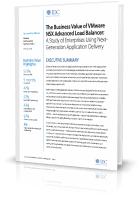Avi Networks vs. F5 Networks
Modernize Your Load Balancing with VMware vs. F5
Unlike appliance-based F5 load balancers, VMware NSX Advanced Load Balancer (Avi Networks) takes a modern architectural approach to deliver multi-cloud load balancing and application services across data centers and clouds.
Avi enables enterprise-grade L4-L7 services with real-time analytics and autoscaling for any app, any cloud, and at any scale. Complete your digital transformation and avoid overspending / overprovisioning by using a single software-defined platform rather than appliance-based F5 load balancing solutions for every individual application environment.
Comparing F5 vs. Avi Networks: When comparing traditional load balancers with Avi, an IDC study on the business value of Avi Vantage found:
